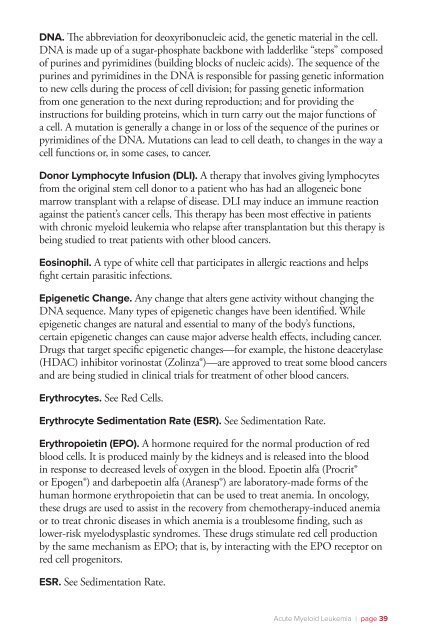Acute Myeloid Leukemia - The Leukemia & Lymphoma Society
Acute Myeloid Leukemia - The Leukemia & Lymphoma Society
Acute Myeloid Leukemia - The Leukemia & Lymphoma Society
- No tags were found...
Create successful ePaper yourself
Turn your PDF publications into a flip-book with our unique Google optimized e-Paper software.
DNA. <strong>The</strong> abbreviation for deoxyribonucleic acid, the genetic material in the cell.DNA is made up of a sugar-phosphate backbone with ladderlike “steps” composedof purines and pyrimidines (building blocks of nucleic acids). <strong>The</strong> sequence of thepurines and pyrimidines in the DNA is responsible for passing genetic informationto new cells during the process of cell division; for passing genetic informationfrom one generation to the next during reproduction; and for providing theinstructions for building proteins, which in turn carry out the major functions ofa cell. A mutation is generally a change in or loss of the sequence of the purines orpyrimidines of the DNA. Mutations can lead to cell death, to changes in the way acell functions or, in some cases, to cancer.Donor Lymphocyte Infusion (DLI). A therapy that involves giving lymphocytesfrom the original stem cell donor to a patient who has had an allogeneic bonemarrow transplant with a relapse of disease. DLI may induce an immune reactionagainst the patient’s cancer cells. This therapy has been most effective in patientswith chronic myeloid leukemia who relapse after transplantation but this therapy isbeing studied to treat patients with other blood cancers.Eosinophil. A type of white cell that participates in allergic reactions and helpsfight certain parasitic infections.Epigenetic Change. Any change that alters gene activity without changing theDNA sequence. Many types of epigenetic changes have been identified. Whileepigenetic changes are natural and essential to many of the body’s functions,certain epigenetic changes can cause major adverse health effects, including cancer.Drugs that target specific epigenetic changes—for example, the histone deacetylase(HDAC) inhibitor vorinostat (Zolinza®)—are approved to treat some blood cancersand are being studied in clinical trials for treatment of other blood cancers.Erythrocytes. See Red Cells.Erythrocyte Sedimentation Rate (ESR). See Sedimentation Rate.Erythropoietin (EPO). A hormone required for the normal production of redblood cells. It is produced mainly by the kidneys and is released into the bloodin response to decreased levels of oxygen in the blood. Epoetin alfa (Procrit®or Epogen®) and darbepoetin alfa (Aranesp®) are laboratory-made forms of thehuman hormone erythropoietin that can be used to treat anemia. In oncology,these drugs are used to assist in the recovery from chemotherapy-induced anemiaor to treat chronic diseases in which anemia is a troublesome finding, such aslower-risk myelodysplastic syndromes. <strong>The</strong>se drugs stimulate red cell productionby the same mechanism as EPO; that is, by interacting with the EPO receptor onred cell progenitors.ESR. See Sedimentation Rate.<strong>Acute</strong> <strong>Myeloid</strong> <strong>Leukemia</strong> I page 39
















